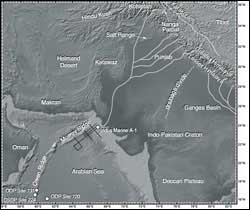Autonomous data-recording devices equipped with hydrophones, deployed in remote waters off Alaska, have been used to track seasonal occurrences of blue, fin, humpback, North Pacific right, bowhead, and sperm whales
Why whales emit their characteristic calls remains largely a biological mystery, but listening for the distinctive underwater sounds provides a valuable way to track the movements of endangered large whales. Autonomous data-recording devices equipped with hydrophones
First air-breathing, liquid fuel-powered scramjet takes flight
Before the sun had even risen over Wallops Island, Va., on 10 December 2005, a joint Office of Naval Research/Defense Advanced Research Projects Agency vehicle achieved a world first. At an altitude of 63,000 feet, the Freeflight Atmospheric Scramjet Test Technique (FASTT) vehicle became the first air-breathing, liquid hydrocarbon fuel-powered scramjet engine to fly.
After launching from the NASA Wallops Fligh
A single unifying physics theory can essentially describe how animals of every ilk, from flying insects to fish, get around, researchers at Duke University’s Pratt School of Engineering and Pennsylvania State University have found. The team reports that all animals bear the same stamp of physics in their design.
The researchers show that so-called “constructal theory” can explain basic characteristics of locomotion for every creature — how fast they get from one place to anoth
The deadly Indian Ocean tsunami that swept across coastlines on 26 December 2004 took the lives of more than 200 000 people. The sheer scale of the catastrophe meant that Earth Observation was vital both for damage assessment and for co-ordinating emergency activities. Through the year that followed, satellite-based maps from ESA’s Respond consortium continued to support rebuilding efforts.
Space-based assistance is being provided through Global Monitoring for Environment and

Scientists have long recognized that the collision of the earth’s great crustal plates generates mountain ranges and other features of the Earth’s surface. Yet the link between mountain uplift and river drainage patterns has been uncertain. Now scientists have used laboratory techniques and sediment cores from the ocean to help explain the how rivers have changed course over millions of years.
In a report published in the December 15 issue of Nature, scientists Peter Clift of t
DNA links genetic lineage of western hemisphere insects to African desert locust
Somewhere between three and five million years ago, a massive swarm of locusts took off from the west coast of Africa and made an unlikely voyage across the Atlantic Ocean to colonize the New World, says an international team of researchers.
Using genetic evidence from more than 20 species of locusts, scientists from the Universities of Toronto, Arizona, Maryland, Cornell University and